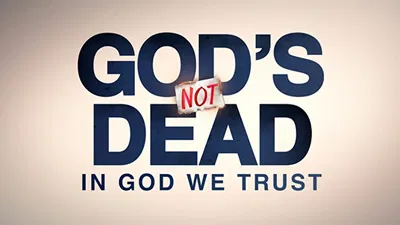Movie Review: Son of God
While the movie Son of God is not able to present all that Jesus did, its omissions distort the central purpose of Christ in coming into the world.
“In the beginning was the Word, and the Word was with God, and the Word was God. He was in the beginning” (John 1:1–2). These words open John’s Gospel. By opening the feature film Son of God also with these words,1 filmmakers Mark Burnett and Roma Downey declare their intent to portray the life of the eternally existent Son of God, Jesus Christ.
Fully God, the Son of God became fully man. “The Word became flesh and dwelt among us” (John 1:14), the Apostle John goes on to tell us in the film. The opening scenes rightly review the truth that the Son of God was busy in the affairs of man throughout the Old Testament. By coming into the world as a human being, Jesus Christ became the ultimate way in which God the Father communicated His love to mankind (John 3:16; Hebrews 1:1–2).
Sadly, however, after this powerful beginning, the film fails to ever make it clear just why Jesus came and why He died.
Bible “Stories”
Gentle Jesus meek and mild
Here’s a Bible story for your little child.
Here I make a play on the Charles Wesley hymn, which connects the character of Jesus to His identity as the Lamb of God, who according to John 1:29 takes away the sin of the world, and to His transforming grace. This movie shows us the meek and mild Jesus but fails to make the connection to sin, repentance, and salvation.
Son of God’s main weakness is not so much the dramatic license it takes; the film’s weakness is in what is missing—the gospel.
To many people the word “story” implies “fairy tale,” but the Bible is not a book of fairy tales and its historical accounts should never be presented as such. Bible “stories”—by which we mean literary adaptations of biblical history—are fine insofar as they portray the people and events described in the Bible as real and historical; this film does that. The best Bible “stories” do not alter biblical facts; unfortunately, this one does present some facts inaccurately, though not much more than most such films. But Bible “stories” fall short when they selectively leave out the parts of the biblical history that carry the Bible’s theological message, the essential truths and teachings—most unfortunately, that describes this rather Pollyanna-version of the life of Christ.
Each family has to decide how much dramatic license it is willing to tolerate in a “Bible movie.” Historical inaccuracies, though few, range from the minor to the major. One significant error involves cinematic Peter’s immediate insight as to the nature of Christ’s Resurrection as not only a “disappearing body” but a Resurrection to a life that would make Him ever-present with His followers. The real Peter and John, finding the tomb empty (John 20:3–10), believed the body was gone but remained somewhat confused (John 20:9) until Jesus later surprised them by appearing to them in a locked room. The cinematic Peter, however, instantly knows that the empty tomb means Jesus is not merely gone but instead exclaims, “He’s back!” Then rushing to the helm of apostolic leadership—rather than awaiting personal encounters with the risen Lord as the Bible records—cinematic Peter, by administering the Lord’s supper (“This is My body . . . this is My blood”) to his fellow disciples, almost magically conjures Jesus’s first appearance to them.
Historically accurate aspects ofSon of God include its portrayal of the fact that the Jewish people of the time wanted a political-military messianic figure. Most failed to understand the sort of Messiah God had sent them. This historical misunderstanding shows itself clearly after the feeding of the 5,000 when, having eaten the miraculously provided meal, the crowd clamored to make Him king (John 6:15). But while the failure of both the people and the Jewish leaders to be satisfied with God’s Messiah is depicted, the fact that Jesus Christ came to save people from theirs sins—sins that otherwise would doom every one of us to hell for eternity—is missing as much in the film as in the miniseries that aired last year.
Gaps in the Gospel
Largely cobbled together from The Bible miniseries that showed in six parts on the History Channel last year, Son of God, as a full-length feature film focusing just on the earthly ministry of Jesus Christ, had the opportunity to make the message of the gospel clearer but really added nothing that would do so. Thus Son of God’s main weakness is not so much the dramatic license it takes with the actual history; the film’s weakness is in what is missing—the gospel.
If the producers only wished to film a good story, that would have been okay. After all, the life, death, and Resurrection of Jesus Christ really make a wonderful narrative, made all the more wonderful because it is true. But the producers have declared their wish that the movie and the miniseries would reach many people with the Word of God. Films can do that, and—while I hope this one does—I fear that biblically illiterate viewers will see nothing in the movie to help them understand how Jesus’s death should benefit them. Though grossing well at the box office, it remains nothing more than a fairly incomplete depiction of Christ as a happy smiling wandering miracle worker that made some downtrodden people feel good about themselves.
By comparison, the 1979 Jesus film set out to film a life of Christ strictly from the Gospel of Luke. That film retained the gospel message and included a narration at the end to make sure viewers understood what the death and Resurrection of Jesus had to do with their eternal destiny. As a result, the Jesus film, distributed through the Jesus Film Project, continues today to be a valuable tool in the hands of missionaries around the world.
Son of God, by contrast, left me wondering if I would have had a clue why the Son of God bothered to get born into this world or why He died on the Cross if I had not already learned from the Bible that I am a sinner and been saved by repenting and trusting in the grace made available to me because Jesus carried my sin and guilt to the Cross (2 Corinthians 5:21).
As with The Bible miniseries, there are some gaps in the gospel message of Son of God. We hear that Jesus is “the way, the truth, and the life,” but we don’t learn that “no one comes to the Father except through Me” (John 14:6). Jesus announces at the Last Supper, “This is My body . . . This is My blood,” and He commands them to repeat these actions in remembrance of Him (1 Corinthians 11:25–26). However, the filmed dialogue leaves out the reason His blood was about to be shed: “This is My blood of the new covenant, which is shed for many for the remission of sins” (Matthew 26:28, emphasis added). Thus the fact that Jesus Christ’s shed blood provides the only way (Acts 4:12; John 14:6; 1 Timothy 2:5–6) to satisfy justice, atone for sin, and reconcile us to God (Romans 5:8–11; 2 Corinthians 5:18) will not be clear to movie-goers who are not already familiar with the gospel. Instead of going to the Bible, a Bible-believing friend, or Bible-teaching church to find out the whole truth, they may simply just wonder why this sort of Jesus is such a big deal and why the film claims He has changed the world.
Power to Change Lives
Truly I cannot find fault with a movie for simply leaving out some of the things that Jesus did, but I find great fault with this film because its omissions distort the central purpose of Christ in coming into the world. The Bible itself records only a selection of teaching and events, as John 21:25 clearly states, “And there are also many other things that Jesus did, which if they were written one by one, I suppose that even the world itself could not contain the books that would be written.” But the teachings, miracles, and events recorded in each Gospel account in the Bible present a complete picture of Jesus Christ as the Son of God and Savior, full of both grace and truth (John 1:14) about how sinful each person is and how much in need of redemption. The Apostle John, under the inspiration of the Holy Spirit, also writes in his Gospel, “And truly Jesus did many other signs in the presence of His disciples, which are not written in this book; but these are written that you may believe that Jesus is the Christ, the Son of God, and that believing you may have life in His name” (John 20:30–31). But the Gospel accounts in the Bible nevertheless do present a balanced account of Jesus’s life, teachings, and post-Resurrection appearances.
But we must surely find fault when a film about the Son of God fails to drive home His mission of coming to seek and save the lost (Luke 19:9–10), calling them to repent and believe in the gospel (Mark 1:14–15). Those who see this film with their unbelieving friends need to be prepared to use the Bible to fill in the gaps in the anemic representation of the gospel and correct the many errors if they wish to use the film to make an eternal difference.
For more information:
Footnotes
- The opening narration begins, “In the beginning was the Word, and the Word was with God, and the Word was God. He was with God in the beginning. He was there in Paradise with Adam and Eve. He was there with Noah in the great Flood. . . .” and goes on to note the presence of the Son of God with Abraham, Moses, and David. The opening narration connects the Old Testament to the Incarnation of Jesus, saying, “In the struggle for the Promised Land He was always by our side. He was the Light shining in the darkness. Then He came into the world. ‘A star shall come out of Jacob and a scepter shall rise out of Israel’ [quoting from the prophecy in Numbers 24:17]. ‘The Word became flesh and made His dwelling among us’ [from John 1:14].”

Answers in Genesis is an apologetics ministry, dedicated to helping Christians defend their faith and proclaim the good news of Jesus Christ.
- Customer Service 800.778.3390
- Available Monday–Friday | 9 AM–5 PM ET
- © 2025 Answers in Genesis




